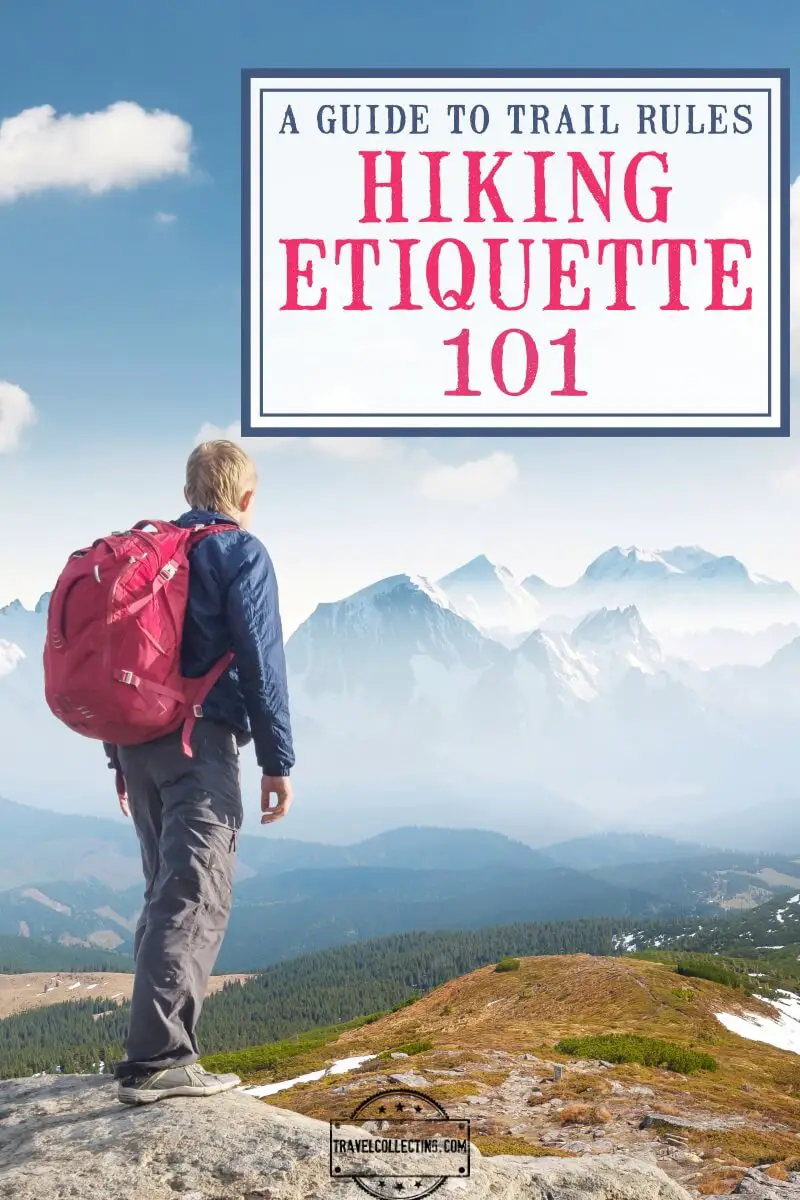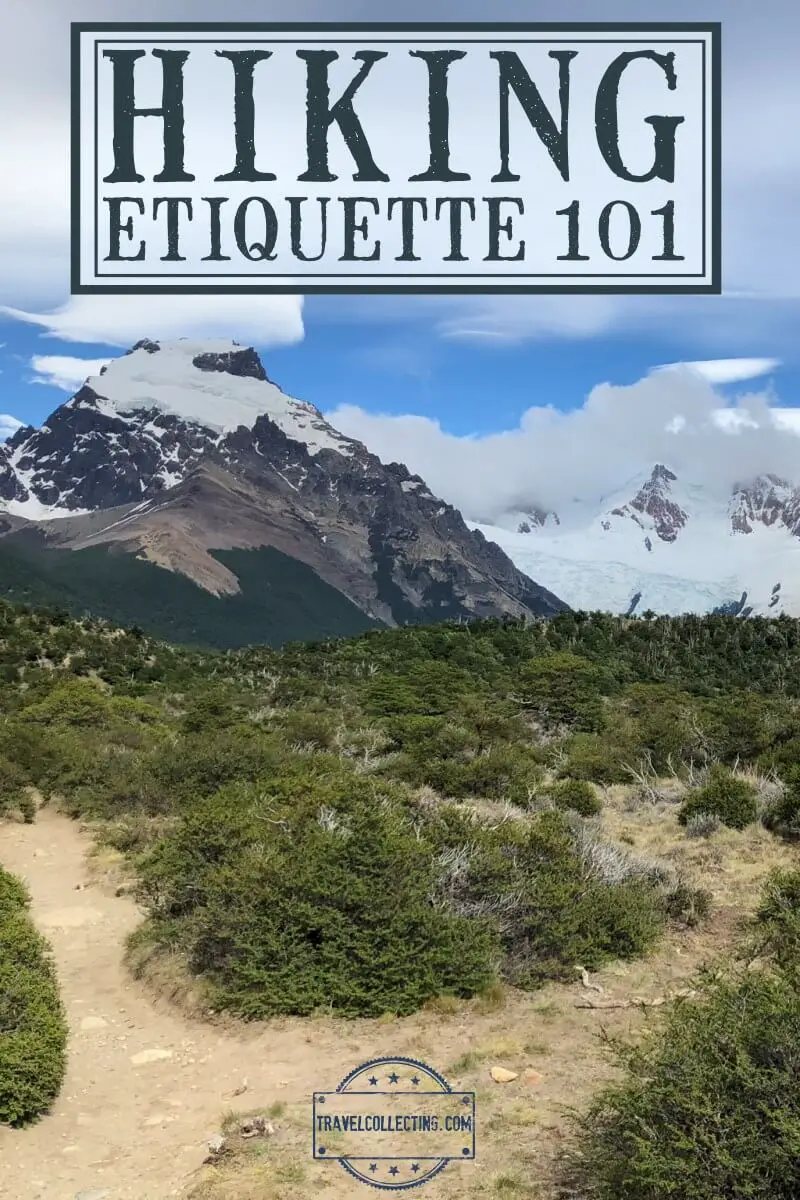You are out on a trail and are starting to get into this whole hiking thing. But then you find yourself wondering about some basic rules of hiking trail etiquette.
Who has right of way when you pass on a narrow trail? Should you say anything to other hikers when you pass them? What should you do with your trash? What about when you need to go to the bathroom? Is it OK to play music? Smoke?
These questions and more are all part of hiking etiquette 101. So let’s take a look.
Hiking Etiquette 101
Subscribe to monthly updates with tips for planning, travel inspiration and trip ideas and get instant access to the free PDF of this
Guide to Hiking Etiquette 101
Right of Way: Hiking Rules for Passing
Yes, there are unwritten rules on who has the right of way on narrow trails.
Other hikers
Hikers who are going uphill have the right of way. If you are going uphill and want a short rest, then you can step aside but technically you have the right of way.
If you’re on a flat section of the trail, there is no ‘rule’, but if it is easy for me to do so, I always step aside so the oncoming hiker can pass, just out of politeness.
A group of hikers also has right-of-way over single hikers or a pair of hikers.
Bikes
Hikers have the right of way over mountain bikes, technically. However, since bikes are usually going more quickly than you, it is usually just easier for the hiker to step aside.
Horses or mules
Horses and mules have the right of way. Try to step as far away as possible (while still staying on the trail) so as not to spook the horse. If there are horses or mules sharing the trail, you might want to keep an eye out for their poop, so you don’t inadvertently step in it.
Let others pass you
If a faster hiker comes up behind you, step aside and let them pass. Remaining in the middle of the trail so that someone can’t pass you and hike at their own speed is considered very bad form is likely to piss them off.
Be friendly
Trail etiquette ‘Hiking 101’ is to say “hello” when you pass other hikers. They won’t expect you to have a long conversation, but a simple ‘hi’ is common. If you are travelling to a non-English country, it is worth learning how to say ‘hi’ in the local language.
If you are ready to be at your destination and wondering how far it is, it is very common to ask a passing hiker how much further it is. If someone asks you, then of course you should stop briefly and tell them.
Being friendly will not only make your day more pleasant, but if you need help from someone, if you have been nice to them, then they are more likely to help you.
In some countries there is a common expression like “Keep going. You can do it!” to offer encouragement for hikers going uphill. In Japanese, it is “Gambate!” and this is very commonly used between hikers.
Keep Noise Down
Always keep noise to a minimum so as not to disturb other hikers’ enjoyment of nature. This includes not talking loudly and not playing music through speakers.
When Nature Calls: Hiking Bathroom Etiquette
When you need to go to the bathroom in a place where there is no bathroom, you need to know what to do. The nest option is to not go. So always take care of business just before you head out, to minimize chances of needing to go while you are on the hike.
If you have to pee, choose a moment when no one is around and go away from the trail and at least 200 feet/ 60 meters from a water source. Step carefully, and avoid any plants. If you use any toilet paper, carry it back out in a Ziplock bag.
To poop, well, try to take care of business before you go on the hike, but if you have to go, go off the trail so as not to stink out the trail, and at least 200 feet/ 60m from a water source, but step very carefully to avoid damaging a fragile environment.
Dig a hole about 4 inches wide and 6 inches deep to bury your poop. Make sure you have toilet paper and a Ziplock bag with you, and take your toilet paper back out with you. It really is better not to go if you possibly can avoid it.
Leave No Trace
Every time you step foot on a trail, you are having some impact on the environment, but there are a couple of key things you can do to keep this impact to a bare minimum.
1. Stay on the trail
With the limited exception of bathroom needs, you should never set foot off the trail. The environment is often fragile and when you step on it, you don’t know what damage you are doing.
2. Take every with you
Every single item and piece of trash that you take with you should be taken back out. Even things that are biodegradable should be taken out. That banana peel may seem innocuous, but you don’t know what tiny germ is in it. I like to take a Ziplock bag with me for trash and if I find another piece of trash that someone else left, I pick that up and take it out with me. The whole point of hiking is appreciating the natural beauty of our planet and if it is covered in trash, it is hard to do!
Smoking
This is a personal pet peeve, but when I am out in fresh air, the last thing I want to do is inhale someone else’s cigarette. It is a potential fire hazard. If you have to have a cigarette, take a portable ash tray to catch all the ash and butt and don’t smoke when other people are around.
Subscribe to monthly updates with tips for planning, travel inspiration and trip ideas and get instant access to the free PDF of this
Guide to Hiking Etiquette 101
I hope this will help you feel comfortable out on the trails.
Do you have any other hiking etiquette tips? I’d love to hear them. Comment below.
For other hiking resources, check out:
- Hiking Guide with things to consider when choosing a hike
- Hiking for Beginners Guide with practical tips for beginner hikers and more
- Essential Gear for beginner hikers
- A Beginner’s Guide on How to Read Hiking Trail Markers
- Packing list for Day Hikes
- General travel resources
- Guide to picking the right Travel Insurance
- Useful Trip Planner
If you found this post helpful, please share the love and Pin It to your Hikes board!
About the author

James Ian has traveled to 82 countries and all 7 continents. He is passionate about experiential travel, i.e. meaningful travel that actively engages with the environment and culture. He helps people have similar experiences that involve active participation in activities and festivals; engaging with the local food and handicrafts through lessons and food tours; and interacting positively with environment by hiking, riding, rowing, diving and low/no impact animal encounters.
Travel Collecting is a participant in the Amazon.com Services LLC Associates Program, an affiliate advertising program designed to provide a means for sites to earn advertising fees by advertising and linking to amazon.com. Amazon and the Amazon logo are trademarks of Amazon.com, Inc. or its affiliates.



